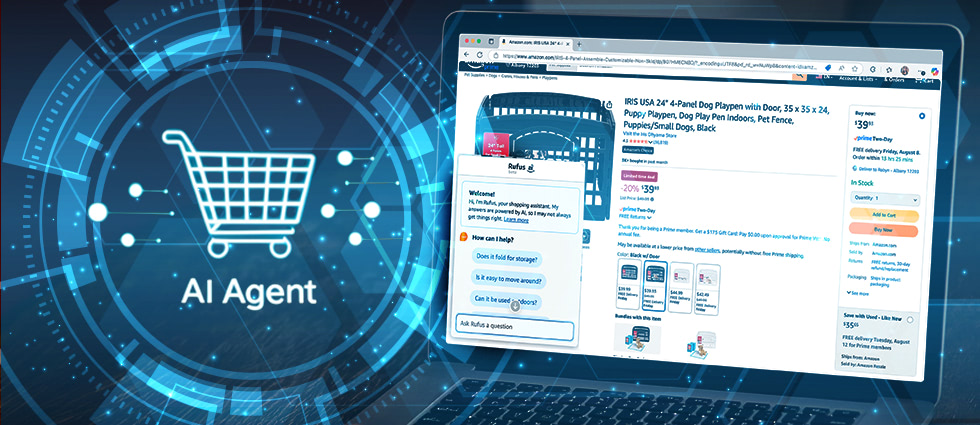Winning the $450 Billion Agentic AI Shift

The Bottom Lines Up Front:
- AI Agents are reshaping online shopping: By 2028, AI agents can generate up to $405B in economic value.
- Financial service organizations have massive opportunity: Payment providers and financial institutions can position their products as the go-to payment method within agentic shopping experiences.
- Market Growth is explosive: The AI-enabled ecommerce market, valued at $7.25B in 2024, is forecasted to hit $64.03B by 2034 – a 24.24% CAGR.
- Privacy is a key limiter – for now: Agentic AI can’t fully complete purchases independently due to privacy and security concerns. Tokenization and similar solutions are currently being tested.
Agentic Commerce 101
Think of agentic commerce as having a super-smart personal shopper that never sleeps. These AI agents can learn a user’s needs, preferences, budget, past purchase history, and then go out and do all the heavy lifting. This ranges from searching across various online marketplaces, evaluating products, reading reviews, comparing specifications, and even negotiating with sellers to secure the best possible price.
Unlike traditional chatbots that respond to prompts, agentic AI operates autonomously. AI agents can find products that match specific criteria, find the most attractive deals and shipping times, and complete purchases automatically, leading to a more efficient and personalized shopping journey (Bank of America Global Research).
The numbers validate this trend: 43% of retailers are piloting autonomous AI, with another 53% evaluating its uses, and 73% of shoppers say AI improves their shopping experience, per Salesforce’s Connected Shoppers Report.
However, as AI agents, like shopping bots, subscription managers, and embedded assistants, start making purchasing decisions on behalf of consumers, financial institutions and their payment partners are tackling a key challenge: enabling these agents to complete transactions autonomously and securely.
Payment Solutioning
One of the most critical solutions emerging is network tokenization. By replacing sensitive Primary Account Numbers (PANs) with secure, randomized tokens, card networks like Visa, Mastercard, American Express, and Discover make it possible for agentic platforms to initiate and complete transactions without exposing raw card data. This is essential for preserving trust and minimizing PCI compliance obligations in environments where human intervention is minimal or nonexistent.
This technology opens the door to more consistent payment experiences across channels and devices. Whether a customer is using a voice assistant, a mobile app, or a smart appliance, tokenization ensures that payment methods remain connected and functional—reducing drop-off during checkout and maintaining continuity across the customer lifecycle.
Tokenization also improves authorization rates by giving issuers access to enriched transaction data and enabling intelligent retry logic when a transaction fails. This matters in agentic commerce, where lost transactions often mean lost opportunities—without the consumer ever knowing.
For financial service marketers, understanding and embracing these shifts is critical. Agentic payments aren’t just a technical evolution—they’re a strategic opportunity to influence how your brand shows up in autonomous commerce environments, where being token-ready may determine whether your card is used… or forgotten.
A New Retail Landscape Has Arrived
Online retail spending growth has outpaced total services spending for several months, with online penetration of retail spending expanding 1.2 percentage points year-over-year in June, according to Bank of America’s latest consumer spending data. But this surge isn’t just about consumer preference—it’s being accelerated by a fundamental shift in how purchases happen.
The Financial Services Opportunity: Three Strategic Imperatives for Card Marketers and Retailers
1. Create Security & Trust
- Payment Networks possess what agentic AI desperately needs: trusted payment infrastructure and security expertise. Visa, Mastercard, and PayPal are launching tokenized AI-friendly payments with spend ceilings and audit trails.
- This isn’t just about processing payments—it’s about providing the security framework that makes autonomous purchasing possible. Only 10% of respondents across North America, Europe, and Latin America indicated they might consider using AI in payments after 2025, with security concerns being a primary hesitation.
Recommended Action Items:
- Position your payment network partner as the secure backbone of agentic commerce
- Develop AI-friendly payment products with built-in spending limits and transparency features
- Create educational content addressing security concerns around autonomous purchases
2. Enhance Transparency
- Agentic AI enhances transparency in online shopping by surfacing hard-to-find information, exposing hidden fees and showing total costs, assessing the credibility of online reviews, and evaluating real-time price comparisons, according to Bank of America Global Research.
- This transparency creates opportunities for payment providers to differentiate through clear, honest communication about fees, rates, and terms—exactly what AI agents will seek when making autonomous financial decisions.
Strategic Considerations:
- Ensure pricing and fee structures are AI-readable and transparent
- Develop APIs that allow AI agents to access real-time account information and spending analytics
- Create content that helps AI agents understand your value propositions clearly
3. Provide Financial Intelligence
- The most compelling opportunity lies in pairing autonomous purchasing with intelligent financial guidance. For example, AI agents can suggest taking advantage of a credit card’s 12-month 0% APR financing when making purchases, creating value for both consumers and issuers.
- Did you know that 70% of shoppers are at least somewhat interested in AI agents helping them optimize their loyalty points (Salesforce)? This newfound excitement of using loyalty points positively contributes to the customer experience, and in turn, has the potential to drive additional card usage.
Implementation Opportunities:
- Retailers can develop AI agents that proactively suggest optimal payment methods based on rewards categories
- For card marketers, develop partnerships with retailers to offer contextual financial products at the point of autonomous purchase
Reasons to Get Ahead of the Pack
The adoption curve is steep. However, 75% of retailers say AI agents will be essential for a competitive edge by 2026.
Considering Generational shoppers is another key aspect of this ecommerce revolution. Gen Z shoppers are 2.7 times more likely than baby boomers to be interested in receiving product recommendations from AI (EMarketer). According to Retail Insider, 71% of consumers want generative AI integrated into their purchasing experiences, with Gen Z and Millennials driving this trend through their preference for hyper-personalization.
With these age considerations in mind, the digital top-of-wallet race is on. Institutions that act sooner to become the trusted financial backbone of autonomous commerce will capture the most value as this $450 billion market unfolds. Those that wait risk becoming commoditized payment processors in a world where AI agents choose financial partners based on transparency, intelligence, and seamless integration.
The agentic AI revolution is here. The question for financial services marketers isn’t whether to participate—it’s how quickly you can position your institution as indispensable to its success.
A Bright Future
Card marketers are eager for merchants to succeed with AI agents, all stemming from the benefits that AI-driven improvements bring to both retailers and their customers AI agents act as a catalyst for this success by creating more engaging and personalized customer experiences, leading to increased loyalty, higher sales, and a greater opportunity for card marketers to thrive.









